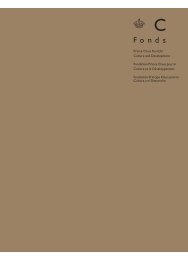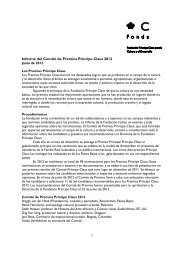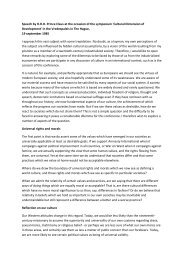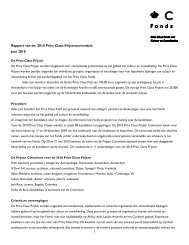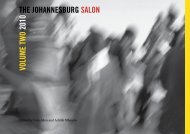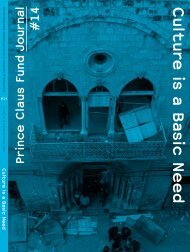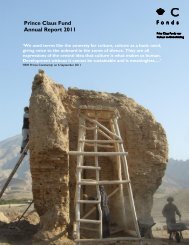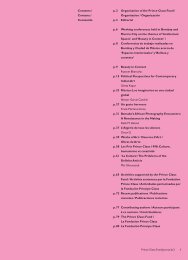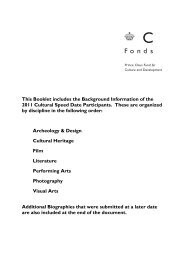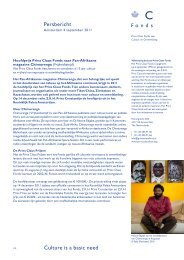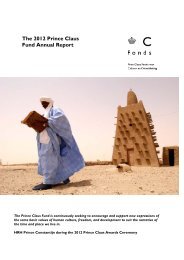3 summer 2011 - Prince Claus Fund
3 summer 2011 - Prince Claus Fund
3 summer 2011 - Prince Claus Fund
- No tags were found...
You also want an ePaper? Increase the reach of your titles
YUMPU automatically turns print PDFs into web optimized ePapers that Google loves.
Ceremony of the guards at Wagah, the Indo-Pakistan bordercombine, as in the case ofthe frenetic genius A.R.Rahman belting out thealternative ‘anthem’ VandeMataram, the people atlarge are also moved tonear frenzy.At our border withPakistan at Wagah inAmritsar, one witnessesyet another conjunction ofthese potent symbols—flag and anthem. Ofcourse, that daily ritual inwhich our two nationsmatch each others’bravado in equal measurehas often been described,but just one furtherrehearsal of the ‘story ofnation’ repeated withquotidian enthusiasm andenjoyed by a capacitycrowd, especially on thepopulated Indian sidewhich has kindly built forus an amphitheatre-likestructure to facilitate theshow, is never entirely out of order.Wagah is authentic Toba Tek Singhcountry, involving the same madmimicry brilliantly captured in Sa’adatHasan Manto’s classic story ofPartition. Identical strips of no-man’sland on both sides; double jeep tracks;sad, divided fields of wheat; and acurious populace eyeing each otheracross tall, spiked gates painted withour respective ‘national colours’encapsulate the ambience of Wagah.As Gore-Bush brigade, so savvy aboutthe superficiality of sign systems,would no doubt comment in their upfrontAmerican democratese—samedifference.Most of all at Wagah, we observethe strapping soldiers ‘on display’plumaged to the hilt and stamping upand down in a border-dance that is atonce touching and terrifying. But justas my trammelled academic mind isbeginning to ask its customary questionsabout the semiotic significanceof these tribal dances, the final buglesblow and the flags are lowered. HarbirSingh, from the Guru Nanak DevUniversity, who has accompanied me,points out that there is a split secondat the end when the Indian andPakistani flags seem to meet as theycome down, although they are severalfeet apart in reality! It is this synchronisedmoment that the cognoscentiwait for—when music and flags cometogether in a fantasy of eternaltogetherness and separation.But, says Harbir, if you look up atthe cloudless skies above Wagah at thatexact time, you are bound to perceiveanother phenomenon which usuallygoes unnoticed. It is a flock of birdscrossing the border—without fuss,without passports, without nationalanthems to sing them into existence!And far, far below these freedomflights, a clutch of families from thefar corners of the peninsula—Kerala,Bihar, Maharashtra—now stragglebrightly dressed out of the Wagahcamp. There is a visible stimulation, anelectric current running through thecrowd at the end of the performance—anda sense of catharsis...It strikes me that we have justwitnessed our essential humanness, inall its vulnerability—its need forsymbolic unity, however questionable.And so, I’d want to contend that itslogical position as a ‘binding’ centrifugaldiscourse within the whirlingvortex of modernity confers on thenational anthem an undeniableauthority. The diverse nation as onefamily is a comforting metaphor thatwe know well. To extend this comparisonto the national anthem would beto assert that it functions as a kind ofmaternal lullaby—but with a dualpurpose. It both soothes the nation,singing it into a moral calm reminiscentof a dream-state; simultaneously,it arouses sentiments that are selfprotectiveand defensive. This psychologicalconflict between peaceful andaggressive instincts lies at the heart ofthe national anthem.Pacifists may find the violenceinternalised in national anthems hardto take but righteous self-assertionseems to go with the terrain here. Anational anthem abounds in cues about‘membership’ because it works on aprinciple of exclusion. Some belong byvirtue of birth, others don’t. Onerecalls at this point the Latin root‘nasci-’ (to be born) of the word‘nation’. The nation is, as it were, thescene or setting of a rebirth—anindividual’s second birth as a citizen.Specific references to a ‘womb’environment of familiar rivers,mountains, landmarks and symbolsthus inevitably shore up and redeemthe otherwise bland reassurances ofsolidarity on offer in an anthem.Reactions to the sound of an anthemare as spontaneous as they would beto maternal speech. They compel usto listen—and to love—withoutquestion and without irony.Consistent with my thesis thatnational anthems are Freudian lullabiesfor populations that can be as large asa billion, music seems an essentialelement of the structure of the nationalanthem. There can be anthems withoutwords—such as those of Spain andYugoslavia, for instance—but nonewithout pulsating musical rhythms.Most national anthems are made to bemarched to and danced to; theyabound in choruses and repetitiveelements that render them memorableand are consequently the one form ofinstitutionalized poetry that even themost prosaic of a country’s citizens areunable to escape! Anthems, it seems,cannot by their very nature, beanathema.That the national anthem is such aPRASHANT PANJIAR / OUTLOOKtouchstone of certainties contrastsintriguingly with its capacity toinstigate uncomfortable queries. Willthe nation state—without which the‘national’ anthem would seem ananomaly—retain its centrality acentury or two from now? Who willbe responsible for the problems of anoverpopulated, aging, environmentallypolluted world—self-contained countriesor a global community? Howmuch will cultures and even humannature alter in response to therevolutionary, and unpredictable,technologies we have invented? Andwill a cosmopolitan anthem alwaysremain a contradiction in terms?Despite its naivete, the nationalanthem functions as a natural vehiclefor the expression of such deepquandaries about once and futureidentity. They serve to replay theAyodhyas of the mind.Conventionally, we know that thebeginning of a millennium marksintellectual disquiet. One useful routetowards imaging this subliminalanxiety is to imagine yet unborn subversionsand supra-versions of ourpresent day anthems. We could beginwith the notion of a ‘world anthem’for instance, in which all the nationsof the world want to raise their voices.Chances are, as I’ve already said, thatsuch a venture might turn out tocontain a logical difficulty becausenational anthems rely on exclusivity.If every one of the world’s six billionhumans is included, who would be leftout except denizens of outer space,animals or plants? I think we can safelyconclude that some alien nation—say,of the Martian variety—will turn outto be a probable motif in anydeterminedly ‘cosmopolitan’ anthemwhich seeks to unite the earth’steeming peoples! And it may be worthnoting at this point that ‘untie’constitutes a neat anagram of ‘unite’.Plurality, after all, is the obverse ofthat pugnacious call to unity socharacteristic of the national anthem.An anthem is predicated on difference,on strands of consciousness tiedtogether that could also comedangerously untied. The strenuousavowal of togetherness in an anthemis not accidental, it verbalises thefundamental unease that cultures havealways felt when faced with radicaldifference. These apprehensions arenot necessarily put to rest in aninformation-rich but empathypoorworld where we have tocome to terms every day withso many unique ‘types’, suchan assortment of individualhuman beings. Now, more thanever, we need to confront thoseancient demons of interculturalconflict. And it is herethat the national anthem mayprove useful as a means ofunderstanding ourselves—creatures who are designed bybiology to thirst for union butwho thrive on difference.Karl Marx’s call to theworkers of the world to unitefor they had nothing to lose buttheir chains resonates in thiscontext. While playing thegame of fantasising about thenational anthems of the future,one might take a leaf out ofMarx’s great failed book here.Intellectual capital—words,books, ideas—versus politicalcapitals—Washington, Beijing,Pretoria. The national anthem drawsproudly on both sources of history.Read via the lenses of a doctrine ofliberation, an anthem is not just aboutunity. It is about unity as a form ofemancipation, of freedom—recallingvia its very existence memories ofsocial fights against oppression and thecultural losses imposed by colonialregimes.Is it possible, then, that the anthemsof the future might become de-linkedfrom the political confines ofnationality? Are national anthems onlya step towards other yet unnamedanthems, such as anthems of gender,of race and of other major coalitionsthat also speak the language ofresistance? Or is this a retrograde idea,throwing us back to a divisive past? Ibelieve the answers to these urgentquestions can be sought in the firstinstance at the dynamic but ambiguousintersection of cultures that nationalanthems so alluringly offer.Finally, I wonder about a whole newconstituency. How would the childrenof this nascent century write or rewritean anthem? For, until they areschooled into learning the story oftheir nation-states, children have otherilluminating narratives—possiblyuniversal in their particularity—abouthow they came into being. I argued alittle earlier that in its unselfconsciousnarcissism, the national anthem isrelated to the timeless universe ofchildhood. It is essentially a nurseryrhyme for adults disseminated acrossan entire population, but in the end Iwant to add that there might well be adisarming wisdom to this process. Ananthem, like a child’s tale, energizes acollective psyche by invokingfoundational myths about selfcreation;in this respect, it offers us avaluable tool for looking back inwonder while at the same time lookinginto our imperilled future with hope.For William Wordsworth, writing afterthe French Revolution (“bliss it wasin that dawn to be alive and to beyoung was very heaven”), we recallthat the child was the father of theman. Perhaps in this new millennium,too, our children offer us our best betsfor an interpretation of cosmopolitanismthat retains the magical spirit ofthe national anthem but goes farbeyond it in imaginative scope.■B I B L I O S P E C I A L I S S U E 2 0 0 2 ● C O S M O P O L I T A N I S M A N D T H E N A T I O N - S T A T E5837 · <strong>Prince</strong> <strong>Claus</strong> <strong>Fund</strong> Reader #3 · Summer <strong>2011</strong>



